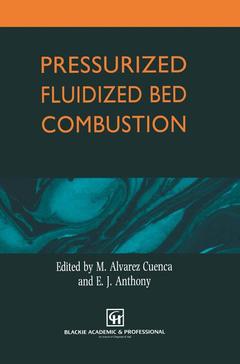Pressurized Fluidized Bed Combustion, Softcover reprint of the original 1st ed. 1995
Langue : Anglais
Auteurs : Alvarez Cuenca M., Anthony E.J.

Pressurized fluidized bed combustion (PFBC) is one of the newest of the coal-based generation technologies available commercially. This authoritative volume contains an excellent balance of the theoretical and practical aspects of PFBC technology, including economics, the fundamental theory of plant design and sorbent characterization, using the results obtained from a wide range of pilot-scale and full-scale demonstration units
1 Introduction.- 1.1 The history.- 1.2 The future.- 1.3 In conclusion.- Acknowledgements.- Appendix: Chronology of events in the development of PFBC.- References.- 2 Fluidization fundamentals.- 2.1 Introduction.- 2.2 Particle dynamics.- 2.3 Bubble dynamics.- 2.4 Bed dynamics.- 2.5 Dynamic similarity.- 2.6 Pressure effects.- 2.7 Heat transfer concepts.- 2.8 Some closing remarks.- 2.9 Nomenclature.- References.- 3 Pressurized combustion in FBC systems.- 3.1 Introduction.- 3.2 Fundamentals of coal combustion in FBC systems.- 3.3 Carbon conversion processes.- 3.4 Nitrogen oxide emissions.- 3.5 Sulfur capture in FBC.- 3.6 Conclusions.- Acknowledgements.- References.- 4 General configuration of a PFBC plant.- 4.1 PFBC cycles.- 4.2 Major components in an FBC plant.- 4.3 Layout considerations.- 5 Solids preparation and handling.- 5.1 Introduction.- 5.2 Lock-hopper feed systems.- 5.3 Coal—water mixture feed systems.- 5.4 Fuel injection into the combustor.- 5.5 Other feed systems.- 5.6 Sorbent preparation and feeding.- 5.7 Comparative availabilities.- 5.8 Summary.- References.- 6 The pressurized combustor.- 6.1 Process configurations.- 6.2 Bubbling fluidization bed steam generator.- 6.3 Circulating fluidized bed steam generator.- 6.4 Auxiliary systems.- References.- 7 High-temperature particulate control.- 7.1 Introduction.- 7.2 HTPC specifications.- 7.3 HTPC concepts.- 7.4 Rigid barrier filter system designs.- 7.5 Rigid barrier filter performance.- 7.6 Conclusions.- References.- 8 Air emissions from pressurized fluidized bed combustors.- 8.1 Introduction.- 8.2 Emissions of sulfur oxides.- 8.3 Emissions of nitrogen oxides.- 8.4 Particulate emissions.- 8.5 Other emissions.- References.- 9 The disposal and utilization of ash residues from PFBC.- 9.1 Introduction.- 9.2 PFBC ashesexamined in study.- 9.3 PFBC ash characteristics.- 9.4 PFBC ash handling.- 9.5 PFBC ash leaching behaviour.- 9.6 PFBC ash utilization.- 9.7 Conclusions.- References.- 10 The combined cycle.- 10.1 Introduction.- 10.2 Basic combined cycle concepts.- 10.3 Pressurized fluidized bed internal combustion combined cycles.- 10.4 Gas turbine integration into PFBC combined cycles.- 10.5 Conclusions.- References.- 11 Energy and exergy analyses of PFBC power plants.- 11.1 Introduction.- 11.2 Energy and exergy analyses.- 11.3 Illustrative example.- 11.4 Summary.- Nomenclature.- Appendix: Sample calculation.- References.- 12 Process control.- 12.1 Process control function and philosophy.- 12.2 Overview.- 12.3 Process control and measurement equipment.- 12.4 Process control, protection and monitoring systems.- 12.5 Unit operation and automatic control.- 12.6 Summary.- 13 The demonstration units: Escatrón and Tidd, four years of operation.- 13.1 Introduction.- 13.2 PFBC in Spain: The selection of PFBC.- 13.3 The Escatrón project.- 13.4 Plant description.- 13.5 Operational experience in Escatrón (1990–1994).- 13.6 Overall performance of the unit.- 13.7 Final remarks.- 13.8 PFBC in the USA: Selection of the technology.- 13.9 The Tidd project.- 13.10 Plant description.- 13.11 Operational experience in Tidd (1990–1994).- 13.12 Overall performance of the unit.- 13.13 Final remarks.- Acknowledgement.- References.- 14 Economics of PFBC technology.- 14.1 Introduction.- 14.2 Economics of turbocharged and air-cooled PFBCs.- 14.3 Economics of first generation PFBC without hot gas filtration.- 14.4 Economics of first generation PFBC with hot gas filtration.- 14.5 Economics of second generation PFBC.- 14.6 Summary of COE for different types of PFBC technologies.- 14.7 General economicconsiderations of PFBC systems.- 14.8 A word about modularity.- 14.9 The economics of using lignite and low rank coals.- 14.10 Future PFBC economics.- References.- Addendum.- 15 Experimental and demonstration plants.- 15.1 Summary.- 15.2 Introduction.- 15.3 Background.- 15.4 Status and technology needs.- 15.5 PFBC first generation, combined cycle.- 15.6 PFBC second generation, advanced cycle.- 15.7 Some PFBC support activities.- 15.8 Abbreviations and acronyms.- References.
This book is an introduction to the principles governing the use of pressurized fluid bed reactors. The first part of the book is an overview of fluidization and combustion while part two deals with pressurized fluid bed combustion. This section covers solids preparation, processing, environmental impact and energy concerns. The final chapter details several demonstration plants.
Date de parution : 09-2012
Ouvrage de 603 p.
15.5x23.5 cm
Thèmes de Pressurized Fluidized Bed Combustion :
Mots-clés :
combustion; control; design; dynamics; emission; exergy; filtration; fluidized bed; heat transfer; plants; preparation; process control; technology; temperature; units
© 2024 LAVOISIER S.A.S.
